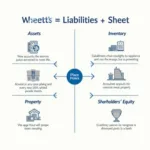The TOEIC Reading section can seem overwhelming, but with the right strategies and preparation, you can ace this part of the exam. Let’s dive into the top Tips To Master TOEIC Sections For Reading Section and boost your score. Whether you’re aiming to understand complex passages or grasp detailed grammatical rules, these tips will guide you towards success.
1. Understand the Structure of the TOEIC Reading Section
The Reading section of TOEIC consists of three major parts:
- Part 5: Incomplete Sentences – You have to choose the correct word or phrase to complete each sentence.
- Part 6: Text Completion – You’ll fill in blanks in a passage to complete the meaning.
- Part 7: Reading Comprehension – You’ll read several types of texts (emails, articles, etc.) and answer questions based on them.
Familiarizing yourself with these formats is key. By understanding the layout, you’ll better manage your time and know what to expect during the test.
“It’s crucial to know the types of questions you’ll face in the Reading section to allocate your time effectively,” says Nguyễn Hoàng Duy, a TOEIC coach with 10 years of experience.
2. Mastering Vocabulary and Grammar for Sentence Completion
Both Part 5 and Part 6 heavily rely on your knowledge of grammar and vocabulary. Some tips to excel in these sections include:
- Study common TOEIC vocabulary: Focus on business, travel, and office-related terms.
- Review grammar patterns: Ensure you’re comfortable with tenses, prepositions, conjunctions, and other essential grammar elements.
- Pay attention to collocations and idiomatic expressions: The TOEIC often tests your understanding of common word pairings, especially in professional contexts.
Pro Tip: Between context clues and grammatical structure, many sentence completion questions can be solved by eliminating wrong choices. Review your grammar rules and rephrase questions in a simpler form when in doubt.
Make sure to also check practical exercises shared in TOEIC test practice techniques with practical exercises to solidify your understanding.
3. Speed Reading for Comprehension
The Reading Comprehension (Part 7) section often trips up candidates due to the large amount of text you need to process. The key here is time management and understanding how to extract key information. To improve efficiency, try these methods:
- Skim and scan the text: Read the passage quickly to get an overall idea of the content and its structure.
- Focus on the questions first: Read the question before diving into the passage. This helps you locate relevant information more effectively and saves time.
- Highlight key information: Take note of dates, names, and numbers in the passage—they are often the answers to the questions.
According to Trần Mỹ Liên, an expert in TOEIC preparation:
“Practicing speed-reading techniques will significantly help with time pressure in the reading section. You don’t need to understand every word of the passage, but know where to find the answers.”
4. Prioritize Time Management
Effective time management can make or break your performance in the TOEIC Reading section. Here’s how you can make sure you don’t run out of time:
- Set time limits for each section: For example, aim to finish Parts 5 and 6 within 20 minutes, leaving more time for the challenging Part 7.
- Answer easy questions quickly: Don’t spend too much time on difficult questions. If you don’t know the answer right away, mark it and come back to it later.
- Allocate more time for double passages: In Part 7, the double passages require more analysis, so budget extra minutes accordingly.
To optimize your preparation further, check out the guide on how to ace TOEIC sections with real exam practice when fine-tuning your time management skills.
5. Practice with Real TOEIC Texts
Practicing with real TOEIC-like materials is crucial. Working through sample tests that include emails, advertisements, or notices familiarizes you with typical TOEIC content.
- Read a variety of materials: Short stories, newspaper articles, business emails, and online posts provide excellent reading practice.
- Simulate test conditions: Get used to the test’s time pressure by timing yourself during practice sessions.
- Analyze your mistakes: After completing each practice, review the questions you got wrong and understand why.
A comprehensive preparation plan using past exam materials is available in the article how to get a high TOEIC score like a pro, designed to elevate your score step by step.
6. Use Context Clues for Unfamiliar Words
During the Reading section, you’re bound to come across unfamiliar words. Don’t panic. Instead, leverage the context:
- Look at the surrounding sentences: See how the unknown word fits within the context of the passage.
- Break down the word parts: Many English words contain prefixes and suffixes that can give clues to their meaning.
- Choose the best-fit answer: Even if you’re unsure, consider the overall tone and meaning of the text when selecting an answer.
Pro Tip: The TOEIC does not expect you to know every word. Trust your instincts and use your overall comprehension of the text to guess unknown vocabulary correctly.
Prompt: Display a TOEIC Reading section screenshot, featuring incomplete sentences, text completion, and reading comprehension parts with a focus on practice tips.
Conclusion
Improving your TOEIC Reading score boils down to a combination of practicing consistently, mastering grammar and vocabulary, and using effective time management techniques. With the tips provided above, you’ll have a solid foundation on how to tackle each part of the Reading section. Most importantly, remember to practice under real test conditions to build your confidence.
If you’re preparing for the test on a tight schedule, read the article about effective TOEIC preparation in one month, which offers strategies for last-minute study.
FAQ: Common Questions about the TOEIC Reading Section
1. How long should I spend on each part of the TOEIC Reading section?
You can try breaking it down as follows: 20 minutes for Parts 5 and 6 combined, and 55 minutes for Part 7.
2. What is the best way to remember vocabulary for the TOEIC Reading section?
Make vocabulary lists from reading materials and practice using the words in context. Flashcards and spaced repetition apps can also help.
3. How many questions in Part 7 should I expect?
You will face about 48 questions in Part 7, including passages with single and double-text formats.
4. Can I use a dictionary during the TOEIC Reading section?
No, dictionaries are not allowed during the exam. It’s important to practice reading without relying on one.
5. What’s the best study routine for the TOEIC Reading section?
Dedicate time each day to both vocabulary study and timed reading comprehension practice. Mix in grammar reviews at least 2-3 times a week.
6. Should I answer all the questions even if I’m unsure?
Yes, there’s no penalty for wrong answers. Always select the best guess if you’re unsure.
7. Is skim-reading an effective strategy for Part 7?
Yes, skim-reading helps you get the general idea quickly, then you can go back and read selectively to answer specific questions.




